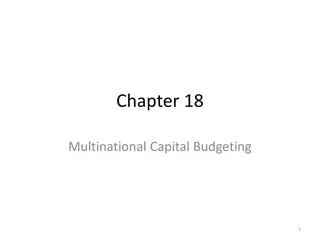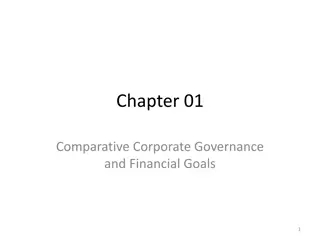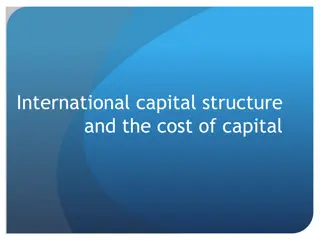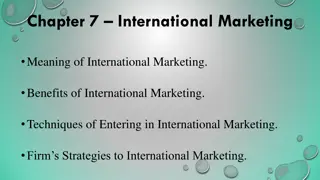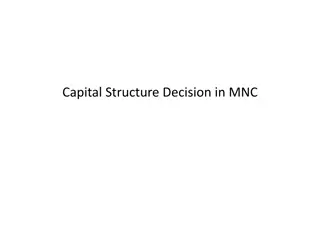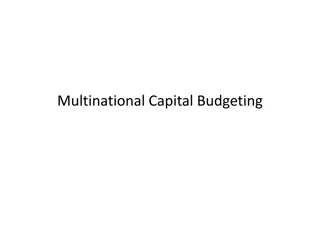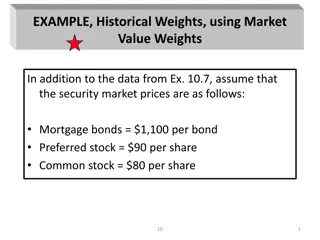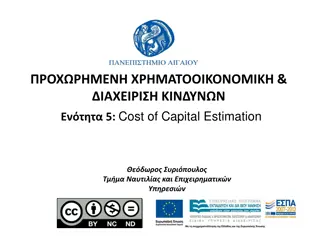Understanding Multinational Cost of Capital
Multinational corporations determine their cost of capital based on the cost of debt and equity. The cost of debt includes the interest rate and credit risk premium, while the cost of equity reflects the risk premium investors demand. Estimating an MNC's cost of capital involves assessing these components to make informed financial decisions.
Download Presentation

Please find below an Image/Link to download the presentation.
The content on the website is provided AS IS for your information and personal use only. It may not be sold, licensed, or shared on other websites without obtaining consent from the author. Download presentation by click this link. If you encounter any issues during the download, it is possible that the publisher has removed the file from their server.
E N D
Presentation Transcript
Multinational Cost of Capital An MNC s capital represents its debt and its equity, its cost of capital is based on its cost of debt and its cost of equity.
MNCs Cost of Debt An MNC s cost of debt depends on the interest rate that it pays when borrowing funds. The interest rate that it pays is equal to the risk-free rate at the time it borrows funds along with a credit risk premium that compensates creditors for accepting credit (default) risk when extending credit to the MNC. Interest expenses incurred by corporations are deductible when determining a corporation s taxable income, there is a tax advantage associated with debt.
MNCs Cost of Equity An MNC creates equity by retaining earnings or by issuing new stock. The firm s cost of retained earnings reflects an opportunity cost, which represents what the existing shareholders could have earned if they had received the earnings as dividends and invested the funds themselves. The MNC s cost of new equity (from issuing new common stock) also reflects an opportunity cost of what the new shareholders could have earned if they had invested their funds elsewhere instead of in the stock. This cost exceeds that of retained earnings because it also includes the expenses (known as flotation costs ) associated with selling the new stock.
MNCs Cost of Equity An MNC s cost of equity contains a risk premium (above the risk-free interest rate) that compensates the equity investors for their willingness to invest in the equity. If investors thought the MNC would offer a future return on equity that was no higher than the prevailing risk-free rate, then they would not invest in its equity because they would rather earn that same return without any exposure to risk by investing in a risk free Treasury security.
MNCs Cost of Equity The equity risk premium that investors would expect in order to invest in an MNC s equity (instead of investing in a risk-free security or in other securities) depends on the risk of the MNC. Those MNCs with higher levels of uncertainty surrounding their cash flows exhibit a higher level of risk. Thus, to entice investors, the stock price of an MNC with high risk must be low enough so that the investment can potentially offer a large enough return to compensate for the risk involved.
Comparing Costs of Debt and Equity There is an advantage to using debt rather than equity as capital because the interest payments on debt are tax deductible. The greater the use of debt, however, the greater the interest expense and the higher the probability that the firm will be unable to meet its expenses. Consequently, as an MNC increases its proportion of debt, the rate of return required by potential new shareholders or creditors will increase to reflect the greater likelihood of bankruptcy.
Comparing Costs of Debt and Equity The trade-off between debt s advantage (tax deductibility of interest payments) and its disadvantage (increased likelihood of bankruptcy) is illustrated. The graph shows the relationship between the firm s degree of financial leverage (as measured by the ratio of debt to total capital on the horizontal axis) and the cost of capital (on the vertical axis). When the ratio of debt to total capital is low, there is not much concern that the firm will go bankrupt because the firm should be able to cover its debt payments easily. Under these conditions, the tax advantage of debt Overwhelms the disadvantage of debt (potential concerns about bankruptcy).
Comparing Costs of Debt and Equity Yet at some point (labeled X in Graph), the debt ratio is high enough to trigger concern by creditors and shareholders about the firm s potential bankruptcy. The larger amount of debt would require the firm to make higher debt payments, which would increase the probability of the firm going bankrupt. At such a higher level of debt, the firm would incur a higher cost of additional debt to reflect the higher level of credit risk.
Comparing Costs of Debt and Equity In addition, investors might require higher returns (which means a higher cost of equity from the firm s perspective) in order to invest because of the firm s higher risk of bankruptcy. Consequently, when the ratio of debt to total capital is beyond point X on the horizontal axis, the cost of capital rises as the ratio of debt to total capital increases.
Comparing Costs of Debt and Equity The firm s cost of capital is minimized at point X, where it benefits from the tax advantage of debt but does not use so much debt that its tax advantage is overwhelmed by concerns about the firm s bankruptcy.
Cost of Capital for MNCs versus Domestic Firms The cost of capital for MNCs may differ from that for domestic firms because characteristics that distinguish MNCs from domestic firms. Size of Firm Access to International Capital Markets International Diversification Exposure to Exchange Rate Risk Exposure to Country Risk of the following
Size of Firm An MNC that often borrows substantial amounts may receive preferential treatment from creditors, thereby reducing its cost of capital. Furthermore, its relatively large issues of stocks or bonds allow for reduced flotation costs (as a percentage of the amount of financing). Note, however, that these advantages are due to the MNC s size and not to its internationalized business. A domestic corporation may receive the same treatment if it is large enough. Nevertheless, a firm s growth is more restricted if it is not willing to operate internationally. Because MNCs may more easily achieve growth, they may be more able than purely domestic firms to become large enough to receive preferential treatment from creditors.
Access to International Capital Markets Multinational corporations are normally able to obtain funds through the international capital markets. Because the cost of funds can vary among markets, the MNC s access to the international capital markets may allow it to obtain funds at a lower cost than that paid by domestic firms. In addition, subsidiaries may be able to obtain funds locally at a lower cost than that available to the parent if the prevailing interest rates in the host country are relatively low.
Example The Coca-Cola Co. s recent annual report stated: Our global presence and strong capital position afford us easy access to key financial markets around the world, enabling us to raise funds with a low effective cost. This posture, coupled management of our mix of short-term and long-term debt, results in a lower overall cost of borrowing. with the aggressive
International Diversification As explained earlier, a firm s cost of capital is affected by the probability that it will go bankrupt. If a firm s cash inflows come from sources all over the world, those cash inflows may be more stable because the firm s total sales will not be strongly influenced by a single economy. To the extent that individual economies are independent of each other, net cash flows from a portfolio of subsidiaries should exhibit less variability, which may reduce the probability of bankruptcy and therefore reduce the cost of capital.
Exposure to Exchange Rate Risk An MNC s cash flows could be more volatile than those of a domestic firm in the same industry if it is highly exposed to exchange rate risk. If foreign earnings are remitted to the U.S. parent, they will not be worth as much when the U.S. dollar is strong against major currencies. This reduces the firm s ability to make interest payments on its outstanding debt, which increases the likelihood of bankruptcy. In addition, an MNC that is more exposed to exchange rate fluctuations will usually have a wider (more dispersed) distribution of possible cash flows in future periods. This could lead creditors and shareholders to require a higher return, which would increase the MNC s cost of capital.
Exposure to Country Risk An MNC that establishes foreign subsidiaries is subject to the possibility that a host country government may seize a subsidiary s assets. The probability of such an occurrence is influenced by many factors, including the industry in which the MNC operates and the attitude of the host country government. If assets are seized and fair compensation is not provided, the probability of the MNC s going bankrupt increases. The higher the percentage of an MNC s assets invested in foreign countries and the higher the overall country risk of operating in these countries, the higher will be the MNC s probability of bankruptcy (and therefore its cost of capital), other things being equal. Other more moderate forms of country risk, such as changes in a host government s tax laws, could also affect an MNC s subsidiary s cash flows. Because it is possible that these events will occur, the capital budgeting process should incorporate such risk.
Example ExxonMobil has much experience in assessing the feasibility of potential projects in foreign countries. If it detects a radical change in government or tax policy, it adds a premium to the required return of related projects. The adjustment also reflects a possible increase in its cost of capital.
In general, the first three factors listed (size, access to international capital markets, diversification) have a favorable effect on an MNC s cost of capital; the next two factors (exposure to exchange rate risk and country risk) have an unfavorable effect. and international It is impossible to generalize about whether MNCs have an overall cost-of-capital advantage over domestic firms. Each MNC should be assessed separately to determine whether the net effects of its international operations on the cost of capital are favorable.
Risk Free Rate The risk-free rate is the interest rate charged on loans to a country s government that is perceived to have no risk of defaulting on the loans. Many country governments are presumed to have no credit risk because they can increase expenditures if necessary in order to have sufficient funds to repay debt. taxes or reduce







